| Columns Retired Columns & Blogs |
"Good audio engineering is timeless." —John Atkinson
Indeed!
To perform the measurements on the McIntosh MC275, I mostly used Stereophile's loan sample of the top-of-the-line Audio Precision SYS2722 system (see the January 2008 "As We See It" and www.ap.com); for some tests, I also used my vintage Audio Precision System One Dual Domain. The MC275 has four output terminals for each channel, one labeled "Common," the others "4," "8," and "16." I performed a complete set of measurements from each output transformer tap using the balanced inputs, and repeated some of the tests using the unbalanced input jacks.
With balanced drive, the voltage gain into 8 ohms was on the low side, at 17.2dB from the 4 ohm tap, 20.5dB from the 8 ohm tap, and 22.7dB from the 16 ohm tap. The unbalanced gains, unusually, were all exactly 6dB higher than the balanced, presumably because of the extra tube stage in this mode. Both balanced and unbalanced inputs preserved absolute polarity (ie, were non-inverting) from all three output taps. (The XLRs are wired with pin 2 hot.) The input impedance at the RCA jacks was a high 86k ohms at low and middle frequencies, dropping slightly and inconsequentially to 62k ohms at 20kHz. The balanced input impedances were all twice these figures, as specified.
The McIntosh's output impedances were on the low side for a transformer-coupled tube design, at 0.33 ohm from the 4 ohm tap, 0.57 ohm from the 8 ohm tap, and 0.87 ohm from the 16 ohm tap. These figures applied at low and midrange frequencies; the impedance at 20kHz was a little higher, at 0.38 ohm (4 ohm tap), 0.7 ohm (8 ohm tap), and 1.1 ohms (16 ohm tap). Even so, the modification of the McIntosh's frequency response due to the interaction between this source impedance and the impedance modulus of the loudspeaker was relatively mild. The gray trace in fig.1, for example, shows the response with the MC275's 8 ohm tap driving our standard simulated loudspeaker. The variations remain within ±0.5dB limits. The limits were ±0.25dB from the 4 ohm tap (fig.2) and ±0.7dB from the 16 ohm tap (fig.3). Note the slight, 0.12dB channel imbalance in this graph, which persisted from all taps into all loads. The McIntosh has wide bandwidth, its high-frequency response into 8 ohms from the 8 ohm tap not reaching –3dB until 91kHz. Its reproduction of a 1kHz squarewave, therefore, was superbly square (fig.4), the flat tops of the waveform confirming the excellent low-frequency extension. The 10kHz squarewave was also superb well shaped (fig.5), with no ringing or overshoot visible. Those big output transformers are obviously of high quality.

Fig.1 McIntosh MC275, 8 ohm output tap, frequency response at 2.83V into: simulated loudspeaker load (gray), 8 ohms (left channel blue, right red), 4 ohms (left cyan, right magenta), 2 ohms (green). (1dB/vertical div.)
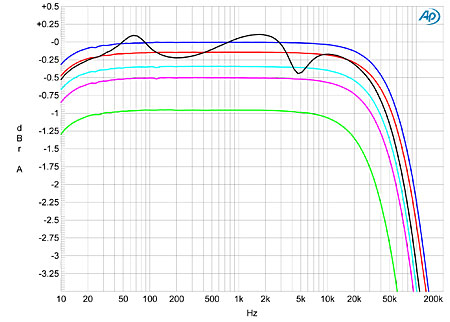
Fig.2 McIntosh MC275, 8 ohm output tap, frequency response at 2.83V into: simulated loudspeaker load (gray), 8 ohms (left channel blue, right red), 4 ohms (left cyan, right magenta), 2 ohms (green). (1dB/vertical div.)
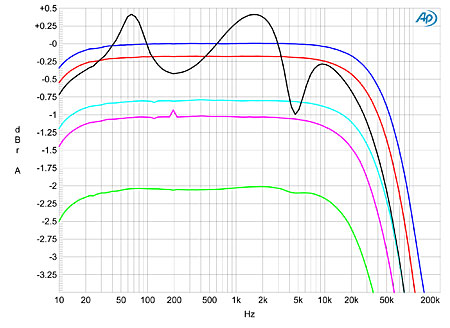
Fig.3 McIntosh MC275, 8 ohm output tap, frequency response at 2.83V into: simulated loudspeaker load (gray), 8 ohms (left channel blue, right red), 4 ohms (left cyan, right magenta), 2 ohms (green). (1dB/vertical div.)

Fig.4 McIntosh MC275, 4 ohm tap, small-signal 1kHz squarewave into 8 ohms.

Fig.5 McIntosh MC275, 4 ohm output tap, small-signal 10kHz squarewave into 8 ohms.
Channel separation (not shown) was better than 90dB below 1kHz, R–L, and better than 112dB in the other direction, which is excellent. The MC275 was also very quiet, with unweighted wideband signal/noise ratios (ref. 1W into 8 ohms) of 89dB left and 88dB right, which are superb, if partly the result of the lowish gain in balanced mode. Restricting the measurement bandwidth to the audioband improved these respective ratios to 96.5 and 93.5dB, while A-weighting the measurements gave 100.2 and 101dB. It's hard to believe that this amplifier was designed in 1961!
Figs.6, 7, and 8 plot the THD+noise percentage against output power from the 4, 8, and 16 ohm output-transformer taps, respectively. With each tap's nominal value matched to the load, the McIntosh amplifier more than meets its specified output power of 75Wpc (18.8dBW), with 90Wpc available from the 4 ohm tap at clipping into 4 ohms (16.5dBW), 85Wpc available from the 8 ohm tap into 8 ohms (19.3dBW), and 92Wpc from the 16 ohm tap into 16 ohms (22.65dBW). (Clipping is defined as 1% THD+N.) These graphs show that the distortion remains well below 0.1% as long as the nominal tap value is equal to or less than the load impedance. (Ignore in some of these traces the sawtooth effects, which are due to the Audio Precision's gain-ranging switching.) But when the load impedance is significantly below the tap value, the distortion quickly rises above 0.1%, even at low powers. So even though the 16 ohm tap offers the highest gain, there will be very few loudspeakers that this tap will drive in a completely linear manner.
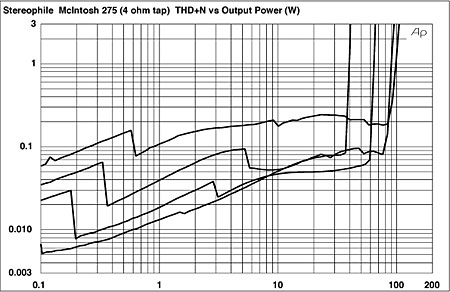
Fig.6 McIntosh MC275, 4 ohm output tap, distortion (%) vs 1kHz continuous output power into (from bottom to top): 16, 8, 4, 2 ohms.
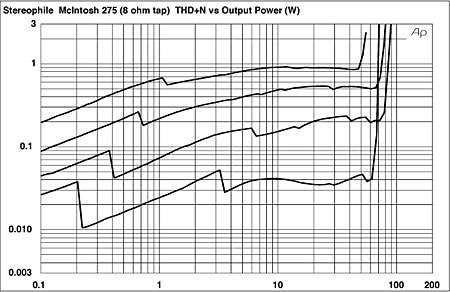
Fig.7 McIntosh MC275, 8 ohm output tap, distortion (%) vs 1kHz continuous output power into (from bottom to top): 16, 8, 4, 2 ohms.

Fig.8 McIntosh MC275, 16 ohm output tap, distortion (%)vs 1kHz continuous output power into (from bottom to top): 16, 8, 4 ohms.
The traces in these last three graphs were taken at 1kHz. However, the MC275 is actually at its most linear in the lower midrange, as revealed by figs.9 and 10, the plots of the THD+N percentage against frequency at 2.83V from the 4 and 8 ohm taps, respectively. With the 4 ohm tap driving 16 ohms, for example, the THD+N is a superbly low 0.004% at 280Hz. The distortion does rise a little at lower frequencies, presumably due to the output transformer's core starting to saturate; and at high frequencies, due to the circuit's decreasing gain-bandwidth product—but this is still a very linear design, as long as the load is equal to or greater than the nominal tap value.

Fig.9 McIntosh MC275, 4 ohm output tap, THD+N (%) vs frequency at 2.83V into: 8 ohms (left channel blue, right red), 4 ohms (left cyan, right magenta), 2 ohms (green).
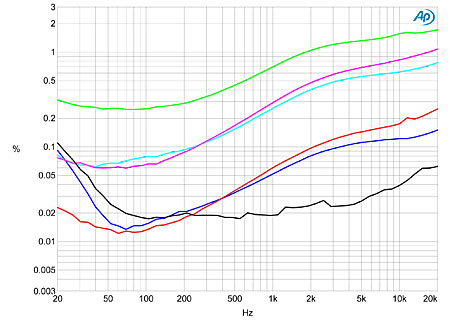
Fig.10 McIntosh MC275, 8 ohm output tap, THD+N (%)vs frequency at 2.83V into: 8 ohms (left channel blue, right red), 4 ohms (left cyan, right magenta), 2 ohms (green).
In the midrange, the predominant distortion present in the amplifier's output is the second harmonic (fig.11), which is subjectively benign even at much higher levels than offered by the MC275. At low frequencies and higher powers, the third harmonic is equal to the second in strength in the right channel (fig.12, red trace), and a regular series of higher harmonics can be seen. Finally, the MC275's reduced top-octave linearity seen in figs.9 and 10 results in a regular series of intermodulation products appearing when the amplifier is asked to drive an equal mix of 19 and 20kHz tones at a moderately high power level (fig.13). Even so, the second-order or difference product at 1kHz, the highest-level spurious tone, lay at –64dB (0.06%), which is still fairly low in absolute terms.
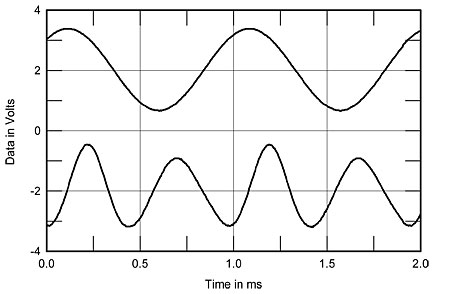
Fig.11 McIntosh MC275, 8 ohm output tap, 1kHz waveform at 1W into 8 ohms (top), 0.05% THD+N; distortion and noise waveform with fundamental notched out (bottom, not to scale).

Fig.12 McIntosh MC275, 8 ohm output tap, spectrum of 50Hz sinewave, DC–10kHz, at 14W into 8 ohms (left channel blue, right red; linear frequency scale).

Fig.13 McIntosh MC275, 4 ohm output tap, HF intermodulation spectrum, DC–24kHz, 19+20kHz at 24W peak into 4 ohms (linear frequency scale).
As I said, it is difficult to believe from its measured performance that the McIntosh MC275 was designed almost half a century ago (by a team led by company cofounder Sidney Corderman, footnote 1). Good audio engineering is timeless.—John Atkinson

"Good audio engineering is timeless." —John Atkinson
Indeed!